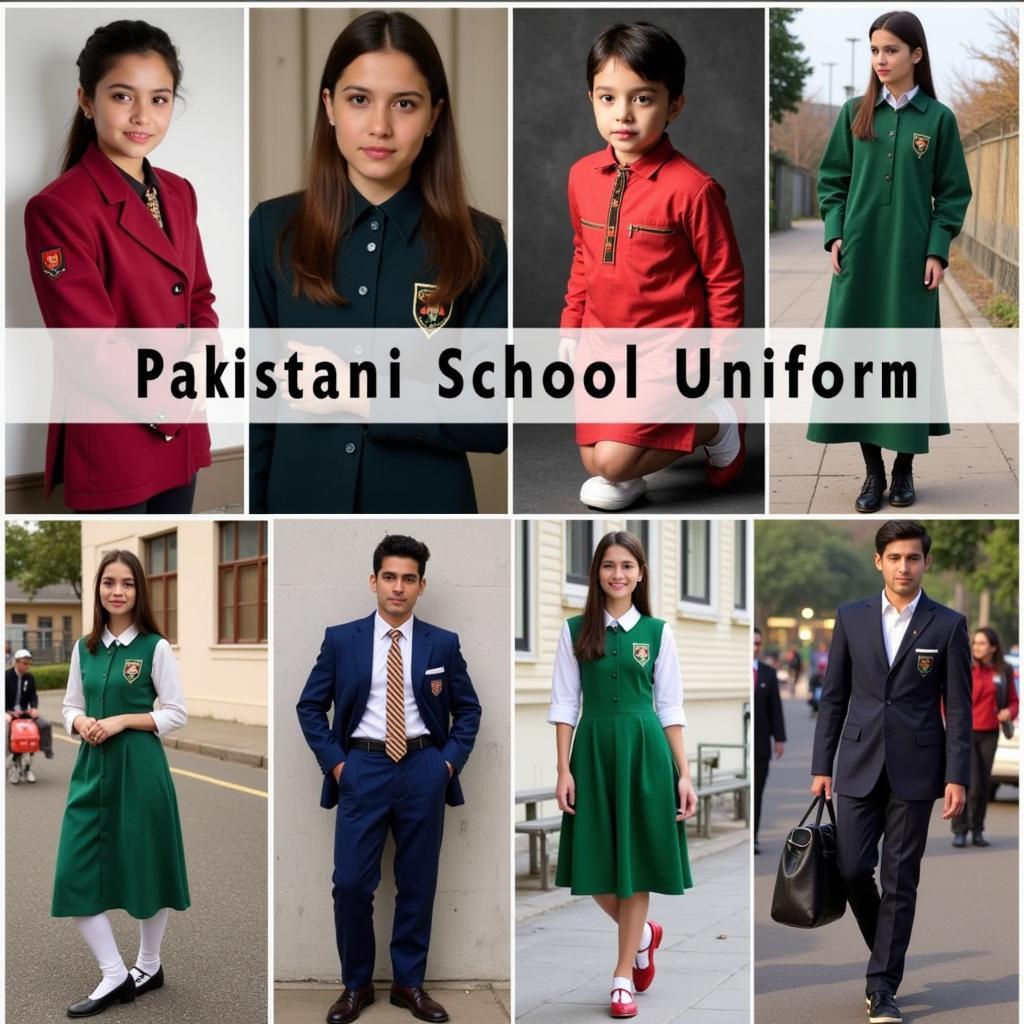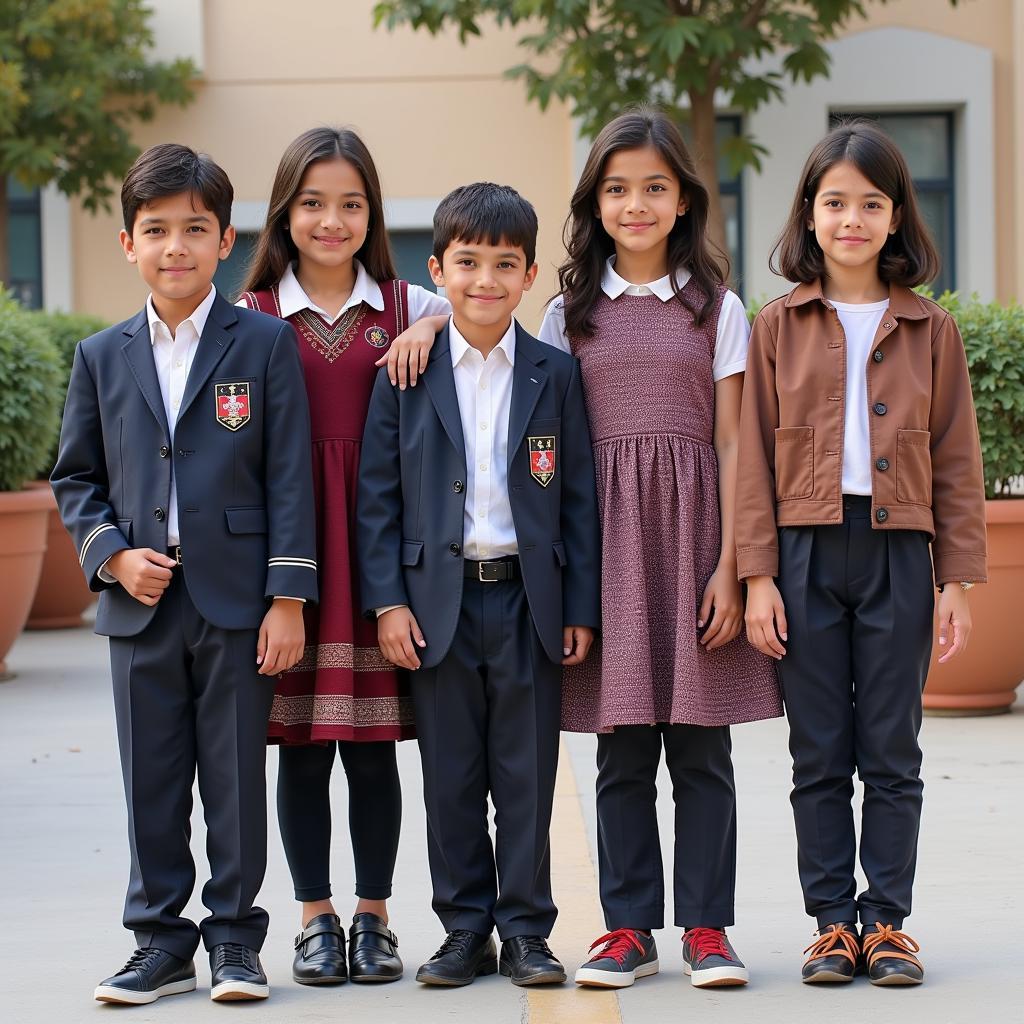School Uniform Design In Pakistan is a topic that elicits diverse opinions and sparks passionate debates. From the classic shalwar kameez to more contemporary styles, the evolution of school uniforms reflects the country’s cultural shifts and evolving educational landscape. This article delves into the multifaceted aspects of school uniform design in Pakistan, examining its historical context, current trends, and the factors influencing this significant aspect of student life.
The History and Evolution of School Uniforms in Pakistan
The concept of school uniforms in Pakistan can be traced back to the British colonial era, where uniforms were introduced as a way to instill discipline and promote a sense of unity among students from diverse backgrounds. Following independence in 1947, Pakistan retained the uniform system, adapting it to align with cultural sensitivities and evolving societal norms.
Initially, school uniforms for boys primarily consisted of a white shirt paired with dark-colored trousers, reflecting the formal attire prevalent during that era. For girls, the shalwar kameez, a traditional South Asian outfit, emerged as the preferred choice, embodying modesty and cultural identity.
Over the decades, school uniform designs in Pakistan have undergone gradual transformations. While the fundamental elements of the shalwar kameez for girls and shirt-trousers combination for boys have remained relatively consistent, variations in color palettes, stitching styles, and fabric choices have emerged.
 Pakistani School Uniforms Through the Years
Pakistani School Uniforms Through the Years
Factors Influencing School Uniform Design
Several factors contribute to the design and implementation of school uniforms in Pakistan. These include:
-
Cultural Considerations: Pakistan’s diverse cultural landscape plays a pivotal role in shaping uniform designs. Maintaining modesty and adhering to Islamic values are paramount, particularly for girls’ uniforms. The shalwar kameez, with its loose-fitting silhouette, effectively addresses these cultural sensitivities.
-
Climate and Comfort: Pakistan experiences a wide range of climatic conditions, from scorching summers to chilly winters. Uniform designs often incorporate breathable fabrics like cotton for summer and warmer materials like wool blends for winter, ensuring student comfort throughout the year.
-
School Identity and Branding: Many schools opt for unique color combinations and emblem placements on their uniforms to establish a distinct visual identity. This fosters a sense of belonging among students and promotes school spirit.
-
Practicality and Affordability: Durability, ease of maintenance, and affordability are crucial considerations for parents. Uniform designs often prioritize simplicity and functionality to ensure they are both practical for daily wear and financially accessible to families across different socioeconomic backgrounds.
-
Evolving Fashion Trends: While cultural sensitivities and practicality remain paramount, contemporary school uniform designs in Pakistan subtly incorporate elements from prevailing fashion trends. This is particularly evident in the use of modern cuts, patterns, and embellishments, catering to the aesthetic preferences of younger generations.
The Debate Surrounding School Uniforms
The topic of school uniforms in Pakistan, as in many parts of the world, sparks ongoing debates with arguments for and against their implementation.
Arguments in Favor of School Uniforms:
-
Promote Equality and Reduce Socioeconomic Disparities: Uniforms minimize the visual distinctions between students from different socioeconomic backgrounds, fostering a more inclusive and equitable learning environment.
-
Enhance Discipline and Focus: Adhering to a dress code can instill discipline and promote a sense of order within the school setting, potentially leading to improved concentration and academic performance.
-
Reduce Peer Pressure and Bullying: By minimizing the emphasis on clothing choices and outward appearances, uniforms can help mitigate peer pressure related to fashion trends and potentially reduce instances of bullying based on attire.
-
Enhance School Safety and Security: Uniforms make it easier to identify students and distinguish them from visitors, potentially enhancing school safety and security measures.
Arguments Against School Uniforms:
-
Restrict Freedom of Expression: Critics argue that uniforms stifle students’ individuality and limit their ability to express themselves through their clothing choices.
-
Financial Burden on Parents: Purchasing uniforms can place an additional financial burden on families, particularly those struggling to make ends meet.
-
Lack of Comfort and Practicality: Some students may find uniforms uncomfortable or impractical for certain activities, particularly during physical education classes or extracurricular pursuits.
-
Limited Impact on Addressing Underlying Issues: Critics argue that while uniforms might address superficial differences, they do not effectively tackle deeper issues like socioeconomic disparities or bullying rooted in other factors.
The Future of School Uniform Design in Pakistan
School uniform design in Pakistan is poised to continue evolving, influenced by technological advancements, shifting societal norms, and the ever-present desire to strike a balance between tradition and modernity.
-
Sustainable and Eco-Friendly Materials: As environmental consciousness grows, incorporating sustainable and eco-friendly fabrics into uniform production is likely to gain traction.
-
Technological Integration: Wearable technology, such as GPS trackers or health monitors, could be seamlessly integrated into uniforms, offering enhanced safety features and promoting student well-being.
-
Customization Options: Schools might offer students greater customization options within the framework of the uniform, allowing for personalized touches while maintaining a cohesive overall look.
-
Increased Inclusivity and Diversity: Uniform policies are likely to become more inclusive, accommodating religious and cultural sensitivities and offering a wider range of size and style options to cater to the diverse needs of students.
 Modern Pakistani School Uniforms
Modern Pakistani School Uniforms
Conclusion
School uniform design in Pakistan is a dynamic and multifaceted aspect of the country’s educational landscape. From its historical roots to its evolving trends, the uniform system reflects cultural values, societal norms, and the ongoing pursuit of creating an optimal learning environment for students. As Pakistan progresses, it’s certain that the conversation surrounding school uniforms will persist, prompting further innovation and adaptation to meet the needs of future generations.
If you’re looking for stylish and affordable boy clothes online shopping in Pakistan, check out our recommended retailers for a wide selection of options.
For those interested in government driver jobs in Pakistan, our comprehensive guide provides valuable information on job requirements, application procedures, and career prospects.
FAQs
1. What is the most common type of school uniform for girls in Pakistan?
The most common type of school uniform for girls in Pakistan is the shalwar kameez, a traditional South Asian outfit consisting of a long tunic paired with loose-fitting trousers.
2. Do all schools in Pakistan require uniforms?
Yes, the vast majority of schools in Pakistan, both public and private, require students to wear uniforms.
3. Are there any specific guidelines regarding the length and style of school uniforms in Pakistan?
Yes, most schools have specific guidelines regarding the length and style of uniforms, particularly for girls. Modesty is paramount, and uniforms generally adhere to cultural sensitivities.
4. What is the typical cost of a school uniform in Pakistan?
The cost of a school uniform in Pakistan can vary depending on the school, the quality of materials, and the number of items included.
5. Where can I buy school uniforms in Pakistan?
School uniforms in Pakistan are typically available at designated uniform shops, local markets, and increasingly, through online retailers.
Need Help?
For further assistance regarding school uniform design in Pakistan or any other related queries, please contact us at:
Phone Number: +923337849799
Email: [email protected]
Address: Dera Ghazi Khan Rd, Rakhni, Barkhan, Balochistan, Pakistan.
Our dedicated customer support team is available 24/7 to assist you.
Leave a Reply